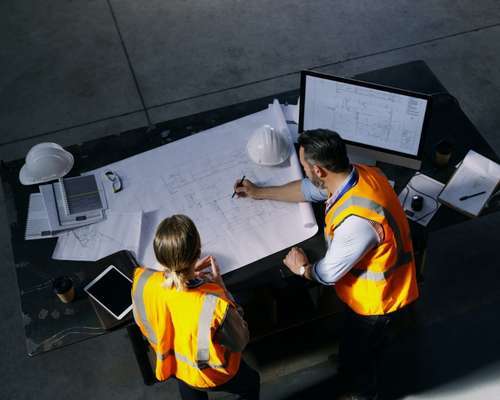Why Construction Submittals Are So Important and How to Manage Them Effectively
0%
Everything you need to know about construction submittals and 9 tips to improve them!
Construction project management involves lots of communication and teamwork. There are many moving parts. To ensure the client is happy with the result, contractors rely on construction submittals to ensure the project is being built according to the correct designs and specifications. These documents lay out a cohesive plan for the design and, in a sense, provide an important set of checks and balances, allowing everyone to be on the same page.
Here is everything you need to know about submittals, including how modern technologies are helping streamline quicker, more accurate submittal workflows.
What Are Construction Submittals?

First, let’s address, just what are construction submittals? In short, these are documents sent to an architect and/or engineer for approval. A submittal outlines the materials and equipment you plan to use during the project. They can also include shop drawings, materials samples, and product data.
Construction submittals generally fall into one of four categories:
- Material or product descriptions or characteristics
- Shop drawings
- Samples
- Mock-ups
Here are a few more things often included in submittals:
- Descriptions of how products or materials will be used
- Color and finish selections
- Jobsite locations and/or phases
- Specified dimensions, placement or other details
- Special requests, questions, customized features, and more
Once submitted, the design and/or engineer team ensures the information matches the project drawing (or that changes or alternatives still fit within the scope of the project). After confirmation, construction workflows can begin. The approval authorizes the quantity and quality of material for fabrication and shipment. It is the final quality-control mechanism before a product arrives on-site.
During the review, process architects clarify product selection based on their quality level. Suppose certain materials need fabrication, such as steel. They confirm details by the fabricator and ensure the required quantities meet needs.
These proposals also impact the cost, quality and schedule of the project. The most successful submittal processes start early on to ensure the project runs smoothly. When materials receive approval before the fabrication, it can help prevent setbacks in the timeline. You can use the gathered information when installing new components.
Why Are Submittals So Important in Construction?

Submittals in construction not only allow for more efficient work, they ensure builders choose the proper materials based on the specific project guidelines. This will enable contractors to stay within project timelines and still deliver quality finished products. The process is essential in providing checks and balances during construction.
The submittal document ensures the result matches the design intent and satisfies the needs of the project owner. Therefore, contractors, architects and the owner should always sit down to discuss responsibilities. All parties should read and document contract provisions as well.
Arguably one of the most critical components of submittal is the shop drawings. These diagrams, schedules and other data outline key elements of the work. The illustrations show design professionals' visual representation of the intended process to understand better how a contractor plans to install certain materials. This ensures everyone uses the proper methods and products.
These documents also allow designers to review project information on a detailed level. That way, they can approve items before fabrication or delivery. This helps prevent timeline delays and costly setbacks. Plus, it ensures construction doesn’t waste materials—which is good for both the environment and contractors’ bottom lines.
Construction Submittals Can Be a Chore—How Technology Is Helping

Technology can help to streamline the process. Though specific submittal software programs are available, more and more contractors are turning to fully-connected, cloud-based construction management suites. These connected platforms tie together construction management workflows like accounting, project management, field teams, architects/engineers, and project owners through a single set of shared data and collaborative workspaces that are easy to access virtually anywhere, any time. This makes sharing data between the office, field and extended project teams easy, improving communication and workflow efficiencies. Connected cloud technologies also make submittal processing and tracking much more efficient and convenient.
Connected cloud construction suites have additional benefits as well, including:
- Real-time project and business data
- Smarter workflows and collaborative processes for better project quality
- Next-level data analytics and reporting to help drill deeper into and better understand how projects are faring at all levels
- Digitization of workflows to reduce reliance on paper and time-consuming manual processes
- Reduced project risks and reduced costs from rework and wrong materials
During the preconstruction and building phases, there can be a mere handful or hundreds of submittals, depending on the size and scope of the project. Keeping track of them all is essential. With specific submittal workflows built into modern construction and project management suites, users benefit from accurate, timely and standardized data sets so everyone is on the same page.
The enhanced collaboration around submittals can also ensure contractors are following safety guidelines as well. Safety is especially important on building sites to prevent injuries. By ensuring the right materials, workflows and specifications are being used at all times increases the odds that the teams in the field are working within the right parameters of the project and with the correct tools and materials-avoiding costly mistakes.
With specific submittal workflows built into modern construction and project management suites, users benefit from accurate, timely and standardized data sets so everyone is on the same page.
Tips for Writing a Construction Submittal
These documents are critical to any successful construction project. Here are a few tips for writing and facilitating effective construction submittals:
1. Know What to Add

The first step is to ensure you have the correct information. This makes the review process simple and prevents project delays.
Make sure to include the following information:
- Specification section number/name/subsection
- Title/description
- Submittal type
- Priority
- Key people, including the contractor, submittal manager and submittal reviewer
- Required date
- Required approval date
2. Track Your Submittal Workflows

Keeping tabs on your construction submittals is important to avoid delays and ensure nothing gets missed. Start with a submittal log to track all the essential documents and when they get approved. A connected construction suite will likely have these features built into the cross-functional project and business management workflows.
3. Automate Certain Processes

Depending on the scale of the project, the specification can be many pages long. An automated submittal log allows you to create a spec book at the beginning. ASLs make a downloadable spreadsheet with your project items in minutes. It then saves you time and reduces the risk of human error, keeping the information more organized. That way, you can spend more time on the design plans and meeting with clients.
When you add collaborators like subcontractors and vendors to the project, they can also submit requests by email. Typically this has been done via email, though modern construction management suites are now replacing these with streamlined submittal workflows and even digital web portals or online collaboration hubs to facilitate quicker turnarounds and better oversight.
4. Ensure Key Information Is Secure

The submittal process can involve multiple documents and data sources, and it is important to keep any sensitive information secure, and out of the wrong hands. Use modern connected construction technologies that provide the right permissionings controls and security protocols to assign things to extended project team members. This ensures the information is confidential and keeps the project moving forward.
Also, make sure you have consistently backed up data, sensitive data encryption and enhanced security protocols like multi-factor authentication when accessing software systems or documents.
5. Add Filters to Find Key Information

With so much information all in one place, it can feel overwhelming. It also makes it easier for things to slip your mind. Technology can help make this process more efficient. Look for software with submittal workflows that allows you to narrow down the list to just what you need.
Some allow you to filter by spec, section, priority, status, approvers and reviewers. This saves you time scrolling through options so that you can find key parts of a submittal quickly.
6. Take Advantage of Dashboards and Email Notifications

The submittal process had multiple steps. Vendors and subcontractors submit documents to the design team to review and approve. Although this process can seem simple and straightforward, it can be lengthy and clunky if using traditional communication outlets like email, one-on-one phone conversations, team meetings or even courier in some cases.
Instead, using connected construction management software, instant dashboard alerts or tasks can be created directly in the system folks are already working in (and can trigger email alerts as well). That way, all team members get the necessary information without cluttering their inbox or scouring through scores of emails. This process also ensures better versioning control by ensuring the most up-to-date documentation is being used at all times, improving accountability and transparency, and empowers people to send responses faster.
7. Centralize the Markup Process

With each submission, multiple people may review and approve the document. Using legacy workflows they might mark up, rename and reorder sheets—reducing productivity, especially if documents have to be updated and shared across multiple platforms or communication channels.
Look for tools that centralize the process and enable digital PDF markups. This way, workers no longer have to export documents and upload them back into the system. The feature allows users to annotate information and even hyperlink to other documents or drawings as well.
8. Allow for Multiple Reviewers at Once

When sending the proposal for review, include multiple parties, such as architects and mechanical designers. However, you can manage and collect feedback quickly by assigning the task to everyone at the same time.
Using connected construction technology can help to speed up this process. It allows you to send documents to multiple reviewers simultaneously. You can add them as co-reviewers so they can place their response in the comment field. Then you need to coordinate and incorporate these notes into the official response. This method holds people accountable and identifies issues to address.
9. Ensure Everyone Is on the Same Page

Keep the team members in mind who need to know the project's status but don’t require any action. You can notify them when you create, send, review or publish a submittal. This way, they are still in the loop—preventing miscommunications down the line. It also ensures no one misses little details due to lack of contact.
Here are a few people to add to that list:
- Additional vendors
- Subcontractors
- Internal team members
- Designers
- Owners
Getting Construction Submittals Right

Submittals in construction are essential for the productivity and safety of projects. They ensure you choose the right materials and meet the clients' needs. That’s why the importance of getting them right cannot be understated.
Using modern connected construction workflows, contractors can significantly improve the construction submittals process. Accurate data, timely responses and better oversight and control ensure materials and steps are up to snuff and contractors are building the projects in the way they’re intended to be built.
If you’re interested in learning more about how connected construction technologies can help improve your construction submittal process, connect with Trimble Viewpoint today!




